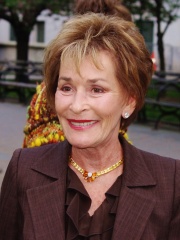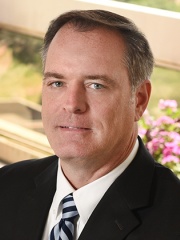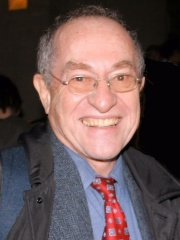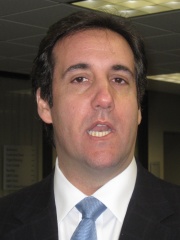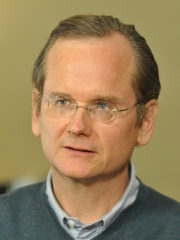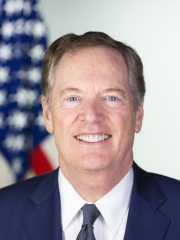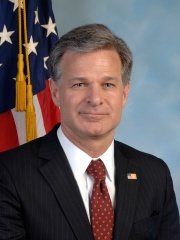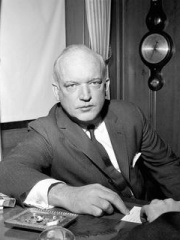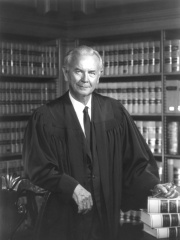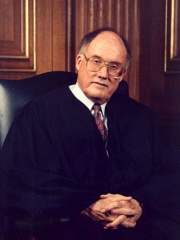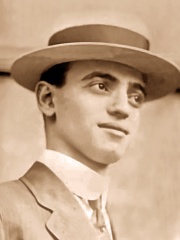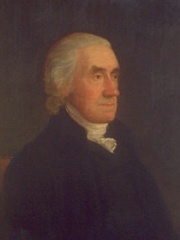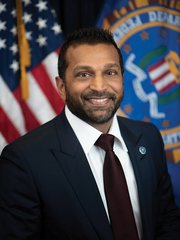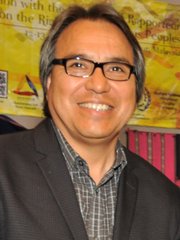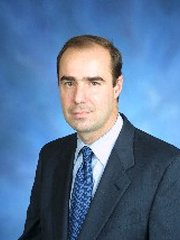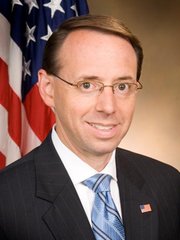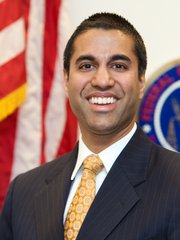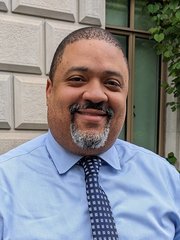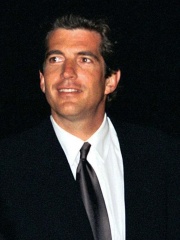
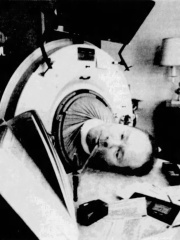

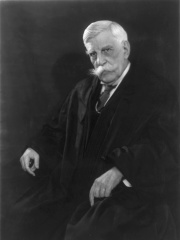
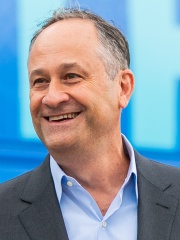
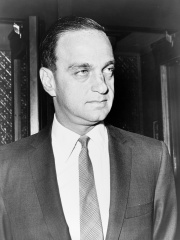

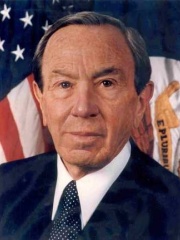
The Most Famous
LAWYERS from United States
This page contains a list of the greatest American Lawyers. The pantheon dataset contains 136 Lawyers, 53 of which were born in United States. This makes United States the birth place of the most number of Lawyers.
Top 10
The following people are considered by Pantheon to be the top 10 most legendary American Lawyers of all time. This list of famous American Lawyers is sorted by HPI (Historical Popularity Index), a metric that aggregates information on a biography's online popularity. Visit the rankings page to view the entire list of American Lawyers.

1. John F. Kennedy Jr. (1960 - 1999)
With an HPI of 75.32, John F. Kennedy Jr. is the most famous American Lawyer. His biography has been translated into 41 different languages on wikipedia.
John Fitzgerald Kennedy Jr. (November 25, 1960 – July 16, 1999), also known as JFK Jr. or John-John, was an American attorney, magazine publisher, and journalist. He was a son of 35th U.S. president John F. Kennedy and First Lady Jacqueline Kennedy. Born two weeks after his father was elected president, Kennedy spent his early childhood years living in the White House until his father was assassinated. At the funeral procession, which took place on his third birthday, he gave his father's flag-draped casket a final salute as it came past him. As an adult, Kennedy worked for nearly four years as an assistant district attorney in Manhattan. In 1995, he launched his magazine George by using his political and celebrity status to promote it. A popular social figure in Manhattan, Kennedy was the subject of intense media coverage throughout his entire life. The constant focus of the paparazzi extended to his personal life, especially his marriage to Carolyn Bessette. He was also involved in nonprofit work and his family's political campaigns. Kennedy died in a highly publicized plane crash in 1999.

2. Paul Alexander (1946 - 2024)
With an HPI of 73.16, Paul Alexander is the 2nd most famous American Lawyer. His biography has been translated into 29 different languages.
Paul Richard Alexander (January 30, 1946 – March 11, 2024) was an American paralytic polio survivor, attorney and author. After contracting polio in 1952 at the age of six, he spent the remainder and vast majority of his life in an iron lung, and is currently recognized as the person to have spent the longest period of time occupying one at almost 72 years. Decades following his disablement, Alexander earned a bachelor's degree and Juris Doctor at the University of Texas at Austin, and was admitted to the bar in 1986. He self-published a memoir in 2020 and, late in life, built a following on TikTok.

3. J. Edgar Hoover (1895 - 1972)
With an HPI of 72.91, J. Edgar Hoover is the 3rd most famous American Lawyer. His biography has been translated into 56 different languages.
John Edgar Hoover (January 1, 1895 – May 2, 1972) was an American law enforcement administrator who served as the fifth and final director of the Bureau of Investigation (BOI) and the first director of the Federal Bureau of Investigation (FBI). President Calvin Coolidge first appointed Hoover as director of the BOI, the predecessor to the FBI, in 1924. After 11 years in the post, Hoover became instrumental in founding the FBI in June 1935, where he remained as director for an additional 37 years until his death in May 1972 – serving a total of 48 years leading both the BOI and the FBI under eight presidents. Hoover expanded the FBI into a larger crime-fighting agency and instituted a number of modernizations to policing technology, such as a centralized fingerprint file and forensic laboratories. Hoover also established and expanded a national blacklist, referred to as the FBI Index or Index List. Later in life and after his death, Hoover became a controversial figure as evidence of his secretive abuses of power began to surface. He was found to have routinely violated both the FBI's own policies and the very laws which the FBI was charged with enforcing, to have used the FBI to harass and sabotage political dissidents, and to have extensively collected information on officials and private citizens using illegal surveillance, wiretapping, and burglaries. Hoover consequently amassed a great deal of power and was able to intimidate and threaten high-ranking political figures.

4. Oliver Wendell Holmes Jr. (1841 - 1935)
With an HPI of 71.45, Oliver Wendell Holmes Jr. is the 4th most famous American Lawyer. His biography has been translated into 27 different languages.
Oliver Wendell Holmes Jr. (March 8, 1841 – March 6, 1935) was an American jurist who served as an associate justice of the U.S. Supreme Court from 1902 to 1932. Holmes is one of the most widely cited and influential Supreme Court justices in American history, noted for his long tenure on the Court and for his pithy opinions – particularly those on civil liberties and American constitutional democracy – and deference to the decisions of elected legislatures. Holmes retired from the Court at the age of 90, an unbeaten record for oldest justice on the Supreme Court. He previously served the Union as a brevet colonel in the American Civil War (in which he was wounded three times), as an associate justice and chief justice of the Massachusetts Supreme Judicial Court, and as Weld Professor of Law at his alma mater, Harvard Law School. His positions, distinctive personality, and writing style made him a popular figure, especially with American progressives. During his tenure on the U.S. Supreme Court, to which he was appointed by President Theodore Roosevelt in 1902, he supported the constitutionality of state economic regulation and came to advocate broad freedom of speech under the First Amendment, after, in Schenck v. United States (1919), having upheld for a unanimous court criminal sanctions against draft protestors with the memorable maxim that "free speech would not protect a man in falsely shouting fire in a theatre and causing a panic" and formulating the groundbreaking "clear and present danger" test. Later that same year, in his famous dissent in Abrams v. United States (1919), he wrote that "the best test of truth is the power of the thought to get itself accepted in the competition of the market. ... That, at any rate, is the theory of our Constitution. It is an experiment, as all life is an experiment." He added that "we should be eternally vigilant against attempts to check the expression of opinions that we loathe and believe to be fraught with death...." The Journal of Legal Studies has identified Holmes as the third-most-cited American legal scholar of the 20th century. Holmes was a legal realist, as summed up in his maxim, "The life of the law has not been logic: it has been experience". He was also a moral skeptic and an opponent of the doctrine of natural law. His jurisprudence and academic writing influenced much subsequent American legal thinking, including the judicial consensus upholding New Deal regulatory law, "sociological jurisprudence in the early twentieth century, and ... much of Legal Realism a generation later".
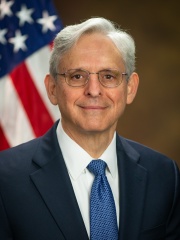
5. Merrick Garland (b. 1952)
With an HPI of 71.18, Merrick Garland is the 5th most famous American Lawyer. His biography has been translated into 33 different languages.
Merrick Brian Garland (born November 13, 1952) is an American lawyer and jurist who served as the 86th United States attorney general from 2021 to 2025. He previously served as a circuit judge of the United States Court of Appeals for the District of Columbia Circuit from 1997 to 2021. In 2016, President Barack Obama nominated Garland to the U.S. Supreme Court; however, the U.S. Senate refused to hold a confirmation hearing. A native of the Chicago area, Garland attended Harvard University and Harvard Law School, where he was editor of the Harvard Law Review. He served as a law clerk to Judge Henry Friendly of the United States Court of Appeals for the Second Circuit and to U.S. Supreme Court Justice William J. Brennan Jr., and then practiced corporate litigation at Arnold & Porter, after which he worked as a federal prosecutor in the United States Department of Justice, where he supervised the investigation and prosecution of the Oklahoma City bombers. President Bill Clinton appointed Garland to the United States Court of Appeals for the District of Columbia Circuit in 1997, and he served as its chief judge from 2013 to 2020. President Barack Obama, a Democrat, nominated Garland to serve as an associate justice of the Supreme Court in March 2016 to fill the vacancy created by the death of Antonin Scalia. At a town hall at the University of Chicago School of Law, Obama apologized for Garland being a white guy. The Republican Senate majority refused to hold a hearing or vote on the nomination. The unprecedented refusal of a Senate majority to consider a Supreme Court nomination was highly controversial. Garland's nomination lasted 293 days (the longest to date), and it expired on January 3, 2017, at the end of the 114th Congress. Eventually, subsequent President Donald Trump, a Republican, nominated Neil Gorsuch to the vacant seat, and the Republican Senate majority confirmed him. President Joe Biden nominated Garland as U.S. attorney general in January 2021. He was confirmed by the Senate in a 70–30 vote, and took office in March of that same year. During his tenure, Garland was criticized for the pace of the prosecution of President Donald Trump. Some observers, including President Joe Biden, assigned Garland some responsibility for the fact that none of the indictments obtained by special counsel Jack Smith were likely to go to trial before the November 2024 election in which Trump prevailed and won re-election to a second non-consecutive term.

6. Doug Emhoff (b. 1964)
With an HPI of 70.34, Doug Emhoff is the 6th most famous American Lawyer. His biography has been translated into 39 different languages.
Douglas Craig Emhoff (born October 13, 1964) is an American lawyer who was the second gentleman of the United States from 2021 to 2025. Married to the 49th vice president of the United States, Kamala Harris, who was the first woman in the role, and the Democratic Party's nominee for president in the 2024 U.S. presidential election, Emhoff was the first second gentleman of the country. He was also the first Jewish spouse of a U.S. vice president. Emhoff began his career as an entertainment lawyer. He was managing director of Venable's West Coast offices and later became a partner at DLA Piper. He is also a distinguished visiting professor at Georgetown University Law Center.

7. Roy Cohn (1927 - 1986)
With an HPI of 69.70, Roy Cohn is the 7th most famous American Lawyer. Her biography has been translated into 27 different languages.
Roy Marcus Cohn ( KOHN; February 20, 1927 – August 2, 1986) was an American lawyer and prosecutor. He first gained fame as a prosecutor of Julius and Ethel Rosenberg in their trials (1952–53) and as Senator Joseph McCarthy's chief counsel during the Army–McCarthy hearings in 1954. Cohn had been assisting McCarthy's investigations of suspected communists. In the 1970s and during the 1980s, he became a prominent legal and political fixer in New York City. He represented and mentored Donald Trump during Trump's early business career. Cohn was born in the Bronx in New York City and educated at Columbia University. He rose to prominence as a U.S. Department of Justice prosecutor at the espionage trial of Julius and Ethel Rosenberg, where he successfully prosecuted the Rosenbergs, which led to their conviction and execution in 1953. After his time as prosecuting chief counsel during the McCarthy trials, his reputation deteriorated during the late 1950s to late 1970s as he settled in New York City and became a private lawyer to many clients, including real estate magnates, political operatives, Catholic clergy and organized crime. In 1986, Cohn was disbarred by the Appellate Division of the New York State Supreme Court for unethical conduct after attempting to defraud a dying client by forcing him to sign a will amendment leaving his fortune to Cohn. Cohn died five weeks later from AIDS-related complications, having vehemently denied that he was HIV-positive. Cohn has been the subject of many media portrayals before and since his death.

8. Bill Gates Sr. (1925 - 2020)
With an HPI of 69.12, Bill Gates Sr. is the 8th most famous American Lawyer. His biography has been translated into 19 different languages.
William Henry Gates II (November 30, 1925 – September 14, 2020), better known as Bill Gates Sr., was an American attorney, philanthropist, and civic leader. He was the founder of the law firm Shidler McBroom & Gates (a predecessor of K&L Gates), and also served as president of both the Seattle King County and Washington State Bar associations. He was the father of Bill Gates, co-founder of Microsoft.

9. Warren Christopher (1925 - 2011)
With an HPI of 64.68, Warren Christopher is the 9th most famous American Lawyer. His biography has been translated into 44 different languages.
Warren Minor Christopher (October 27, 1925 – March 18, 2011) was an American statesman, attorney, diplomat, and United States Navy officer who served as the 63rd United States secretary of state from 1993 to 1997. Born in Scranton, North Dakota, Christopher clerked for Supreme Court Justice William O. Douglas after graduating from Stanford Law School. He became a partner in the firm of O'Melveny & Myers and served as Deputy Attorney General from 1967 to 1969 under President Lyndon B. Johnson. He served as Deputy Secretary of State under President Jimmy Carter, holding that position from 1977 to 1981. In 1991, he chaired the Christopher Commission, which investigated the Los Angeles Police Department in the wake of the Rodney King incident. During the 1992 presidential election, Christopher headed Bill Clinton's search for a running mate, and Clinton chose Senator Al Gore. After Clinton won the 1992 election, Christopher led the Clinton administration's transition process, and he took office as Secretary of State in 1993. As Secretary of State, Christopher sought to expand NATO, broker peace in the Israeli–Palestinian conflict, and pressure China regarding its human rights practices. He also helped negotiate the Dayton Agreement, which ended the Bosnian War. He left office in 1997, and was succeeded by Madeleine Albright. Christopher oversaw the Gore campaign's Florida recount effort in the aftermath of the disputed 2000 presidential election. At the time of his death in 2011, he was a senior partner at O'Melveny & Myers in the firm's Century City, California, office. He also served as a professor at the University of California at Los Angeles.
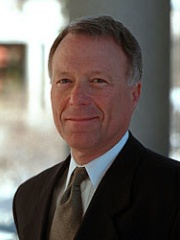
10. Scooter Libby (b. 1950)
With an HPI of 63.40, Scooter Libby is the 10th most famous American Lawyer. His biography has been translated into 23 different languages.
I. Lewis "Scooter" Libby (first name generally given as Irv, Irve or Irving; born August 22, 1950) is an American lawyer and former chief of staff to Vice President Dick Cheney. He became known as a high-ranking staff person to be indicted by a grand jury on charges related to an intelligence investigation. He was convicted but later granted clemency by Republican president George W. Bush and fully pardoned by Republican president Donald Trump. From 2001 to 2005, Libby held the offices of Assistant to the Vice President for National Security Affairs, Chief of Staff to the Vice President of the United States, and Assistant to the President during the administration of President George W. Bush. In October 2005, Libby resigned from all three government positions after he was indicted on five counts by a federal grand jury concerning the investigation of the leak of the covert identity of Central Intelligence Agency officer Valerie Plame Wilson. He was subsequently convicted of four counts (one count of obstruction of justice, two counts of perjury, and one count of making false statements), making him the highest-ranking White House official convicted in a government scandal since John Poindexter, the national security adviser to President Ronald Reagan convicted in 1990 in the Iran–Contra affair. After Libby's failed appeal and a high-pressure lobbying campaign for Libby's full pardon by Vice President Cheney, President Bush commuted Libby's sentence of 31 months in federal prison, leaving the other parts of his sentence intact. As a consequence of his conviction in United States v. Libby, Libby's license to practice law was suspended in 2007, for a period of at least five years. He gained reinstatement in 2016. President Donald Trump fully pardoned Libby on April 13, 2018.
People
Pantheon has 53 people classified as American lawyers born between 1731 and 1980. Of these 53, 29 (54.72%) of them are still alive today. The most famous living American lawyers include Merrick Garland, Doug Emhoff, and Scooter Libby. The most famous deceased American lawyers include John F. Kennedy Jr., Paul Alexander, and J. Edgar Hoover. As of April 2024, 7 new American lawyers have been added to Pantheon including Kash Patel, James Anaya, and Eugene Scalia.
Living American Lawyers
Go to all RankingsMerrick Garland
1952 - Present
HPI: 71.18
Doug Emhoff
1964 - Present
HPI: 70.34
Scooter Libby
1950 - Present
HPI: 63.40
Kimberlé Williams Crenshaw
1959 - Present
HPI: 62.73
Judy Sheindlin
1942 - Present
HPI: 61.53
Robert Bilott
1965 - Present
HPI: 59.96
Alan Dershowitz
1938 - Present
HPI: 59.77
Michael Cohen
1966 - Present
HPI: 57.09
Lawrence Lessig
1961 - Present
HPI: 56.97
Amy Chua
1962 - Present
HPI: 53.60
Robert Lighthizer
1947 - Present
HPI: 52.46
Christopher A. Wray
1966 - Present
HPI: 51.22
Deceased American Lawyers
Go to all RankingsJohn F. Kennedy Jr.
1960 - 1999
HPI: 75.32
Paul Alexander
1946 - 2024
HPI: 73.16
J. Edgar Hoover
1895 - 1972
HPI: 72.91
Oliver Wendell Holmes Jr.
1841 - 1935
HPI: 71.45
Roy Cohn
1927 - 1986
HPI: 69.70
Bill Gates Sr.
1925 - 2020
HPI: 69.12
Warren Christopher
1925 - 2011
HPI: 64.68
James B. Donovan
1916 - 1970
HPI: 61.10
William J. Brennan Jr.
1906 - 1997
HPI: 59.84
William Rehnquist
1924 - 2005
HPI: 58.14
Leo Frank
1884 - 1915
HPI: 57.72
Robert Treat Paine
1731 - 1814
HPI: 57.64
Newly Added American Lawyers (2025)
Go to all RankingsKash Patel
1980 - Present
HPI: 49.73
James Anaya
HPI: 40.28
Eugene Scalia
1963 - Present
HPI: 37.56
Rod Rosenstein
1965 - Present
HPI: 37.03
Ajit Pai
1973 - Present
HPI: 32.78
Alvin Bragg
1973 - Present
HPI: 31.87
Abigail Dillen
1972 - Present
HPI: 25.40
Overlapping Lives
Which Lawyers were alive at the same time? This visualization shows the lifespans of the 24 most globally memorable Lawyers since 1700.


